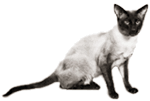Type
by Sheelagh Le Cocq
Many people ask
me:
“What is
the difference between Traditional and Classic Siamese?”
I also see
adverts for ‘Traditional Siamese’ and hear of breeders offering ‘Traditional’
kittens when all the time they are referring to Classic Siamese.
So what are
the differences in types, and how can we make it clear to people what these
types are like?
Traditional
Siamese
We will start
with the Traditionals, which are the most old-fashioned of the three classifications
of type.
 Traditionals
are the main type of Siamese that first came to this country a little over
100 years ago. I say ‘main’ type because it seems that even then, there
were possibly two different types, one slightly less rounded and stocky
than the other, if the pictures in Frances Simpson’s “The Book of the Cat”,
published in 1901, are anything to go by. However the most common old-type,
and the one most people identify with, is the true Traditional or “Applehead”
as they are sometimes called in the USA - a term which is used in a derogatory
sense by some judges and officials when discussing our type with us, and
by certain ‘Modern’ breeders.
Traditionals
are the main type of Siamese that first came to this country a little over
100 years ago. I say ‘main’ type because it seems that even then, there
were possibly two different types, one slightly less rounded and stocky
than the other, if the pictures in Frances Simpson’s “The Book of the Cat”,
published in 1901, are anything to go by. However the most common old-type,
and the one most people identify with, is the true Traditional or “Applehead”
as they are sometimes called in the USA - a term which is used in a derogatory
sense by some judges and officials when discussing our type with us, and
by certain ‘Modern’ breeders.
Betty White,
a breeder of American ‘Moderns’ writes on the efforts to re-introduce the
Traditionals in the USA. Predictably, the elegant Siamese [Modern] was
nearly loved to extinction as cats with heavy boning, round heads and washed-out
blue eyes began to appear in increasing number - a clear indication of
mixed ancestry and indiscriminate breeding. Knowledgeable Siamese breeders
and lovers coined the phrase “Appleheads”.
Traditionals
should be large cats, have a cobby body and a round or apple-shaped head,
large eyes, strong, sturdy legs and a medium length sturdy tail. The coat
of true Traditionals is short but thick and plush like velvet, not thin
and fine like Moderns. It is very hard to find the right coat texture today,
many cats have either very fine coats or harsh coarse fur.
Kay Hill writes
in The Heirs about her stud cat roaming the
Yorkshire Moors in winter, and rolling in the show like a dog. Most Traditionals
were like that, oblivious to cold, rain or snow and were far healthier
than their modern counterparts.
Although seen
in many cats of the past, crossed eyes and kinked tails are not part of
the Traditional. These faults were bred out many years ago.
Modern
Siamese
Modern Siamese
need little introduction, as their type can be seen at most shows. They
are at the opposite end of the spectrum from the Traditional. Although
Moderns in the UK are on the whole less extreme than those in the USA,
I have seen some - particularly red, cream and tabby points - that are
not very different and are dreadful to see.
The best description
of Moderns that I can give is from Betty White, who says:
“Everything
about a [Modern] Siamese is long, except its coat. A [Modern] Siamese has
fine bones, a long tubular body, long tail, long neck, long head, long
legs - long, long, long. Situated on that long head is a long wedge-shaped
head with large ears which complete the wedge. The body is covered by a
short silky coat which is relatively thin, making the breed an ideal cat
to live indoors.”
Modern Siamese
often have small, sunken eyes, totally unlike the beautiful large eyes
of both other types, and these cause many eye problems and infections.
The cats are more delicate, more prone to illness and shorter lived than
the more normal Traditional and Classic.
Classic
Siamese
The Classic
is a cross between the Traditional and the Modern, a move away from the chunky, round-headed cat to a
lighter, slightly long headed cat, without
going to extremes.
 Many
of the Classics in the 1960s and 70s were very, very beautiful, and quite
a few of our members want only to go back this far: to cats like Gr. Ch. Amberseal Electo and Gr.
Ch. Penyrallt Picasso to name but two.
Many
of the Classics in the 1960s and 70s were very, very beautiful, and quite
a few of our members want only to go back this far: to cats like Gr. Ch. Amberseal Electo and Gr.
Ch. Penyrallt Picasso to name but two.
The Classic
should have a medium body, neither cobby nor thin; a medium, wedge-shaped head, neither round nor pointed like
Concorde; medium sized ears; legs
and tail that are neither short or stocky nor thin and whip-like or resembling
a piece of string. Above all, this cat should have the large eyes of the
Traditional. The coat should be of medium thickness and can be plush, though
not many have this coat type, but it should never be fine and thin like
Moderns.
In short, the
Classic is a medium type of cat, no extremes in anything; a well-balanced,
beautiful animal with everything in moderation.
Top of Page
